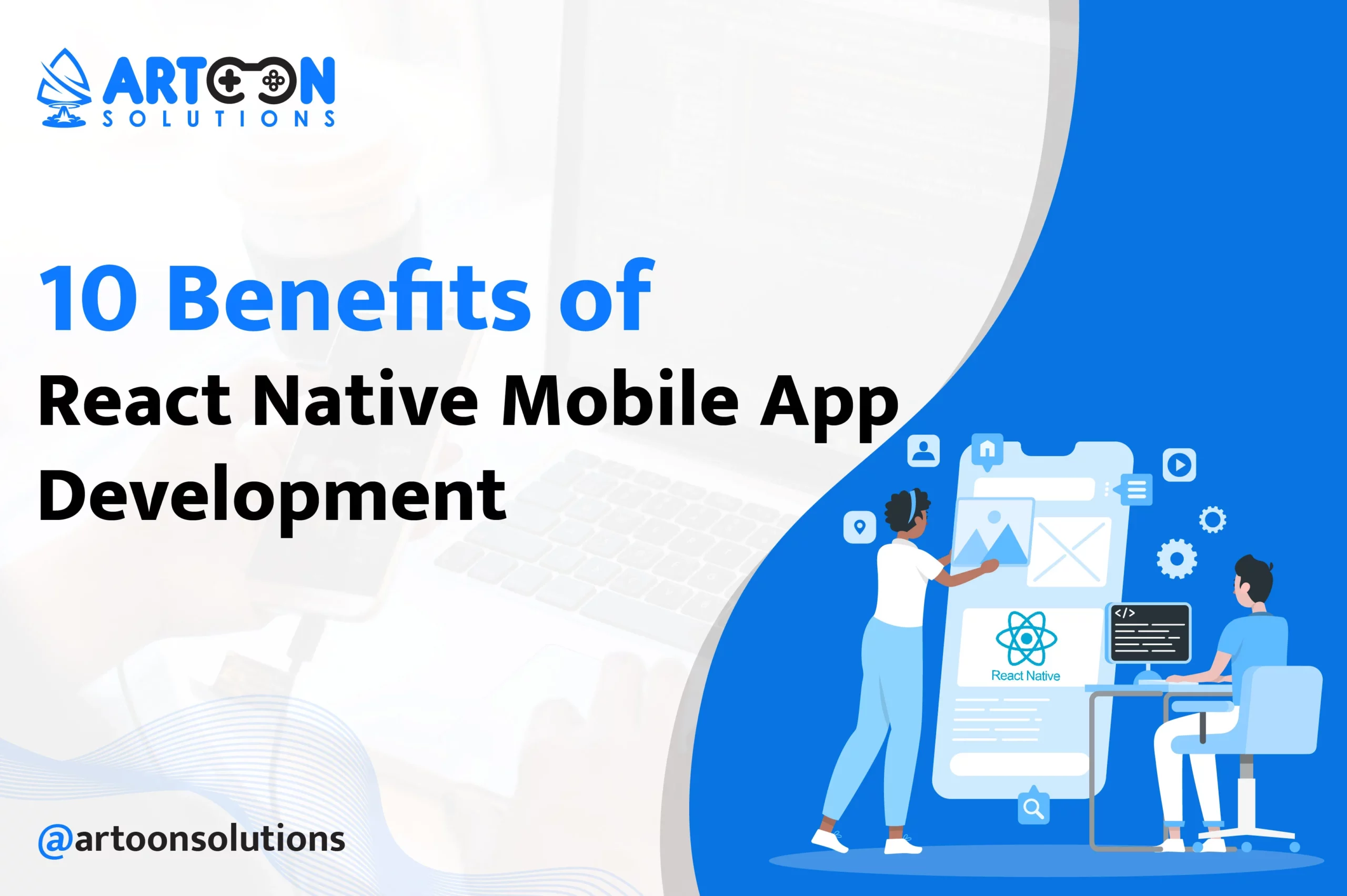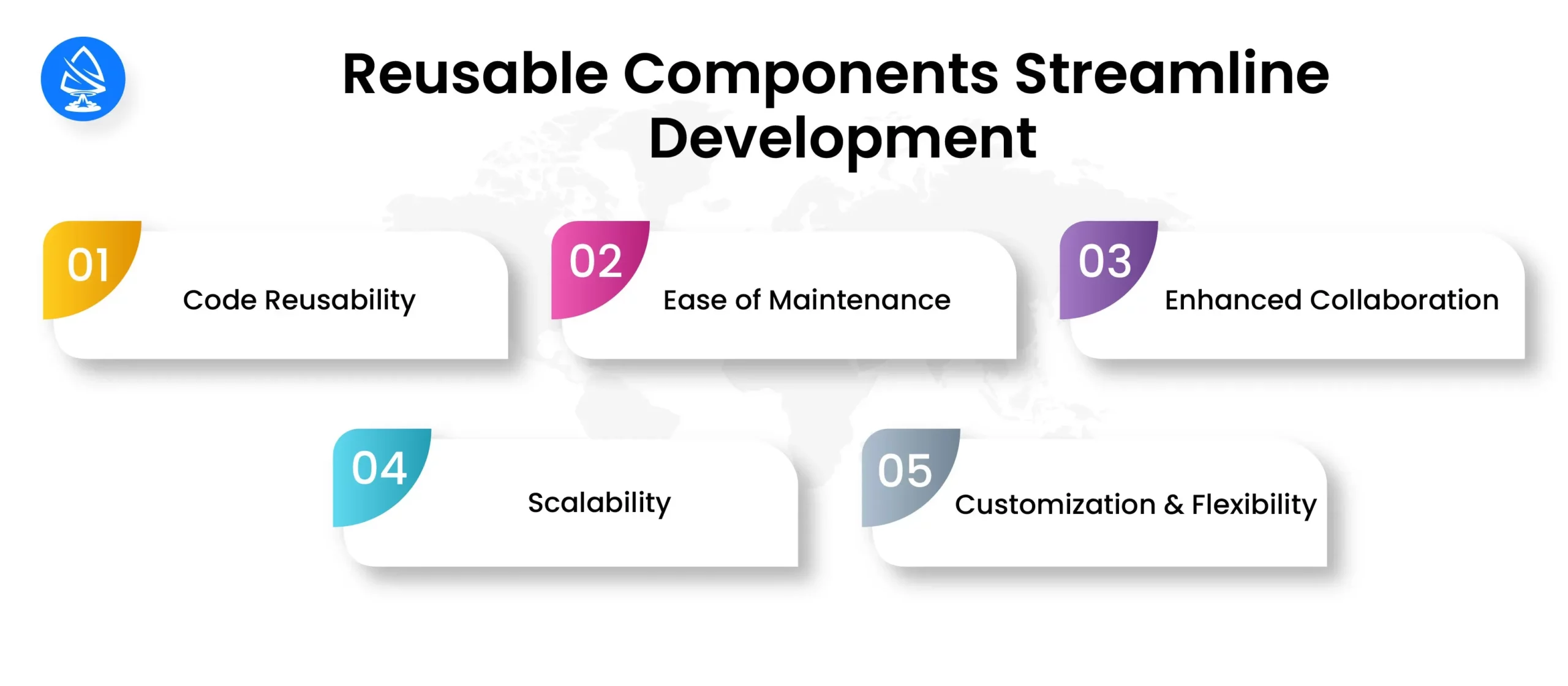- HR:+91-879-9184-787
- Sales:+91-908-163-7774

Do you know about the benefits of React Native mobile app development? If yes, you’re at the right place. React Native is a popular framework developed by Facebook specially for mobile app development. React Native allows developers to use JavaScript along with native platform capabilities which help to build high-performance mobile applications. The choice of framework impacts development speed, cost, maintainability and scalability. With the growing demand for mobile applications, businesses need reliable and efficient solutions to stay competitive in the market. In this blog, we will explore the top 10 benefits of using react native application development services for mobile app development. Let’s dive straight into it.
Do you know about Cross-platform development? If not, worry not. Cross-platform development refers to the practice of creating software applications that are compatible with multiple operations systems using a single codebase. In the context of mobile app development React Native, this means building an app that can run seamlessly on both iOS and android devices without writing separate code for each platform. This approach reduces the development time and efforts while giving a consistent user experience across different devices.
How React Native Enables Cross-Platform Mobile App Development
React Native application development allows developers to write a single JavaScript codebase that runs on both iOS and Android platforms. You can take advantage of native components, React Native makes sure that apps perform well and deliver a user experience comparable to native development.
React Native mobile development speeds up the process which makes it an attractive choice for developers and businesses. React Native uses one codebase for both iOS and android platform which reduces time required to build and deploy apps. This streamline the development approach & eliminates the need to write separate code for each platform which results in faster development cycles and resource management.
React Native mobile app development offers a standout feature called hot reloading, which allows developers to instantly see the effects of their code changes without losing the app’s current state. This means developers can tweak code and immediately view updates in the app which eliminates the need for full reloads.
React Native’s single codebase and hot reloading combine for significant time-to-market advantages:
Explore React Native animation libraries with insights from our detailed guide.
React Native mobile app development significantly cuts down on cost by enabling developers to use one codebase for both iOS and Android. Unlike traditional methods that require separate teams and codebases for each platform, React Native streamlines development efforts and lowers overall expenses. This unified approach not only saves time but also ensures cost-effective app development without sacrificing quality.
React Native’s shared codebase streamlines mobile app development by enabling one team to manage both iOS and Android projects. This simplifies project oversight and eliminates the need for multiple platform-specific teams, reducing costs and enhancing efficiency.
React Native’s cost efficiency offers considerable economic advantages, particularly for startups and small businesses with limited budgets.
React Native mobile app development is known for its high performance. It takes advantage of native components alongside JavaScript which allow smooth operations on iOS and Android. This approach makes sure that apps perform almost as well as native ones with quicker development times.
React Native mobile application development delivers near-native performance for mobile apps. It uses native components compiled into native code that ensures smooth animations, fast loading and seamless navigation. This architecture also optimizes memory usage which makes it ideal for high-performance applications.
React Native has powered several notable apps known for their performance:
These apps demonstrate how React Native enables developers to create robust, high-performing mobile applications that meet modern user expectations.
React Native mobile development benefits from a large, active developer community since its launch by Facebook in 2015. This global community shares knowledge, offers support and continuously improves the framework which makes it easier for developers to learn and advance their mobile app projects.
React Native has extensive resources, including tutorials, documentation and forums to help developers. Numerous libraries and third-party plugins extend its functionality which enable easy integration of complex features. These resources streamline development and enhance efficiency.
These tools are well-documented and regularly updated, ensuring developers have access to the latest features.
React Native’s strong community support is invaluable for troubleshooting and innovation. Developers can quickly get help through forums, social media, and websites like Stack Overflow, making problem-solving efficient.
The community also fosters innovation by sharing experiences, solutions, and new ideas. This collaboration drives the development of new features and best practices, keeping React Native a cutting-edge framework.
Overall, the robust community support, extensive resources, and collaborative environment make it an excellent choice for mobile app development Re, ensuring developers can build high-quality, high-performance apps with confidence.
Explore the seamless integration of React Native and Android in our insightful blog post.
React Native mobile app development uses reusable components—modular units of code that encapsulate specific functions or UI elements. These can be reused across different parts of an app or even in multiple apps, making development more organized and maintainable.
You can use reusable components in React Native to boost efficiency and consistency. Developers can quickly build new features using a library of pre-designed components to avoid redundant code. For example, a button component used across multiple screens ensures uniform appearance and behavior which enhance the user experience. Any updates to a component automatically apply to all instances which simplifies the maintenance.

Reusable components in React Native boost efficiency, consistency, and scalability, making it an excellent choice for modern mobile app development.
React Native mobile app development simplifies app maintenance with a single codebase for both iOS and Android. This unified approach means developers write, debug, and maintain one set of code, saving time and effort. Its modular architecture allows easy updates and modifications, as changes to one part of the app don’t disrupt the whole application.
Updating and adding new features in React Native is efficient and straightforward. With hot-reloading, developers can see code changes instantly without recompiling the app, speeding up development. Reusable components simplify adding new features by allowing developers to integrate existing elements, ensuring consistency and saving time. React Native also supports over-the-air (OTA) updates, enabling direct updates to users’ devices without app store downloads, ensuring users receive the latest features and fixes quickly.
The long-term benefits of using React Native for mobile app development are significant. Here are some of them:
React Native supports efficient maintenance, updates, and long-term app management, making it ideal for modern mobile development.
React Native mobile app development is great at creating rich and engaging user interfaces. By using JavaScript and native components, developers can build visually appealing and highly responsive UIs that feel like native applications. The framework supports various UI elements, animations, and gestures, allowing developers to create sophisticated interfaces that enhance the user experience.
React Native also offers a large ecosystem of pre-built components and libraries to help developers quickly build beautiful and functional user interfaces. Tools like React Native Paper and NativeBase provide customizable UI components that follow platform-specific design guidelines, ensuring a consistent look and feel across both iOS and Android devices.
Great UI/UX design is crucial for mobile apps. Here’s why:
Many top apps use React Native for their appealing UI/UX:
React Native excels in delivering rich UI and UX. It helps developers create apps that are not only visually appealing but also highly functional, ensuring a great user experience.
Mobile application development React Native is flexible, allowing integration with native code when necessary. While you can build complete apps using JavaScript and native components, sometimes you need to use native code for specific features or performance boosts.
React Native’s architecture includes a bridge that connects JavaScript and native modules. This bridge lets developers call native functions and access native APIs directly from JavaScript. This means you can write parts of your app in Swift, Objective-C, or Java/Kotlin when needed, combining the best of both worlds.
Combining React Native with native app development offers many advantages:
Real-World Scenarios Where This Integration is Advantageous
You can integrate native code within React Native mobile app development enhances performance, accesses native APIs, and improves user experiences. This hybrid approach combines the best of both worlds for robust, high-performing apps.
React Native is robust, versatile, and designed for future scalability. Its core architecture, which uses both JavaScript and native code, ensures that it can evolve with technological advancements. This makes it a great choice for businesses looking to invest in a scalable and future-proof mobile app development framework.
React Native’s modular structure lets developers build scalable apps that can grow over time. By organizing code into reusable components, developers can efficiently manage and expand their apps. Integration with native modules ensures that future performance or feature requirements can be met without major changes.
React Native is constantly evolving to stay current with new technology trends. Here’s how:
Investing in React Native offers several long-term benefits:
Artoon Solutions is a top provider of React Native application development services. Our team of React Native experts focuses on creating high-quality, cross-platform mobile applications that meet your business needs. Ready to start your React Native project? Contact Artoon Solutions today to discuss your needs and discover how our React Native application development services can benefit your business.
React Native mobile app development offers a wealth of benefits, including high performance, strong community support, reusable components, easy maintenance, rich UI/UX capabilities, seamless integration with native code, and future-proof scalability. These advantages make React Native an ideal choice for developing robust, efficient, and engaging mobile applications. If you’re planning your next mobile project, consider the expertise of React Native experts at Artoon Solutions to bring your vision to life. Contact us today to explore our React Native application development services and take the first step toward creating an exceptional mobile app.
A framework for building mobile apps using JavaScript and native components.
For cross-platform development, cost efficiency, and faster time-to-market.
By enabling rich, responsive interfaces and seamless animations.
Yes, it can integrate native code for platform-specific features.
Yes, it evolves with tech trends and supports scalability.
Copyright 2009-2025